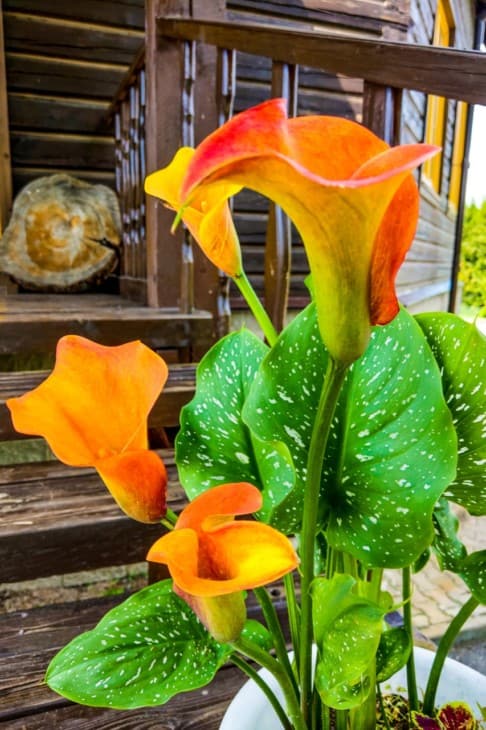With the scientific name Zantedeschia Aethiopica, Calla Lilies are well-known plants used most often for their ornamental benefit in gardens, pots, and flower arrangements. Calla Lilies are extremely easy to grow and are indigenous to southern Africa. While beautiful and extremely enjoyable plants to grow, they are inherently hazardous to humans and pets alike.
Contents
Calla Lilies are poisonous – or rather, toxic – to humans, dogs, cats, and most other animals. This is due to high levels of insoluble calcium oxalate crystals that are small and sharp in nature, causing swelling and pain if they make contact with the sensitive tissues in the body.
Also Read: When Are Calla Lilies In Season? | Calla Lily Alternatives
In order to avoid any adverse effects of toxicity from Calla Lilies, it’s important that you understand how to prevent the consumption of any parts of the plant by your family or pets, and ensure that you know what to do in the event that somebody accidentally consumes a part of this ornamental plant.
Related:
– Are Tiger Lilies Poisonous?
– Are Peace Lilies Poisonous?
– Are Daylilies Poisonous?
Calla Lilies Toxicity
Calla Lilies have long been used as ornamental plants in gardens and flower arrangements alike. They are stunning flowers with bright, vibrant colors and dark green leaves, making them a prime choice for use in flower arrangements and gardens alike.
There are numerous names by which the Calla Lily is known, including the Pig Lily, Richardia Africana, Richardia aethiopica, Trumpet Lily, Garden Calla, White Arum, Florist’s Calla, and Arum Lily. The Calla Lily is also known by its scientific name, Zantedeschia aethiopica.
This plant is toxic to dogs, cats, and humans alike. Bear in mind that it is the entire plant that is toxic instead of only a small part of it. This means that the roots, stems, leaves, and flowers are all toxic and should not be consumed in any amount, however small.

What Makes Calla Lilies Poisonous?
The reason for this plant’s toxicity is mainly due to the presence of calcium oxalate crystals. These tiny, sharp crystals can cause moderate to severe pain along with hoarseness, difficulty swallowing, and in severe cases, swelling up of the oesophageal tube.
On a simplistic level, the calcium oxalate crystals essentially stab and irritate the sensitive tissues of the tongue, gums, and throat with the possibility of causing irritation in the gastrointestinal tract.
The juices of the Calla Lily are also toxic, and if they come into contact with your skin, they can cause a burning sensation along with pain and swelling in some cases.
If this plant or its juices come into contact with the eyes, it can cause pain, watery eyes, redness of the eyes, and damage to the cornea in severe cases.
What Are The Symptoms Of Calla Lily Poisoning In Humans?
Symptoms of poisoning from Calla Lilies can range from mild to severe, and this will differ from person to person. The most common signs of Cala Lily poisoning to watch out for include:
- an intense feeling of burning in the mouth or tongue and general irritation in these areas
- if somebody has difficulty swallowing, this is another sign that they might have ingested part of a calla lily. This is due to the calcium oxalate crystals that have caused irritation and possibly, inflammation
- a decreased appetite might be another indication of poisoning, as is vomiting
What Are The Symptoms Of Calla Lily Poisoning In Dogs?
If you suspect your dog has consumed parts of a Calla Lily, there are numerous signs to watch out for. This includes :
- excessive drooling
- pain in the mouth
- a lack of interest in food
- and any signs of vomiting
Constantly pawing at the mouth is a sure sign that a dog has ingested something that has caused major irritation to its mouth and throat
The above is caused as a result of the raphides from the plant (the needle-shaped crystals of calcium oxalate) essentially injecting themselves into the tissue, thereby causing histamines to be released while causing major irritation for the person or animal that has consumed a part of the plant.
If your dog has started to vomit and you suspect it is a direct result of the consumption of Calla Lily, then the vet may request to conduct testing on the vomitus to establish toxicity levels.

How Do You Treat Dogs Poisoned By Calla Lilies?
If the amount of Calla Lily consumed has been significant for the size of the dog, there is a possibility that renal failure might occur, and this may result in a need for the euthanization of the animal.
While this result might be extreme, it is a very real possibility, which is why one should not take the consumption of this lily lightly when it comes to your beloved pets and always take them to the vet as soon as possible if you suspect this is what has occurred.
In order to treat the dog, any remaining parts of the plant will need to be removed from its mouth. The raphides from the plant are exceptionally sharp and will continue to cause pain for the animal if they are still present.
If the dog is struggling to breathe, the vet may need to insert a tube into the esophagus to help with breathing, along with oxygen therapy. Inducing vomiting may also be of assistance if the dog has not already vomited of its own accord.
Next, the introduction of intravenous fluids will assist the kidneys in helping to excrete the toxins and ensure the dog remains hydrated.
How Can I Prevent Calla Lily Poisoning?
While Calla Lilies are not necessarily life-threatening to all humans and animals, there is a strong likelihood that they can cause harm. In some cases, the adverse reactions to the consumption of calla lilies can become life-threatening, especially to a dog.
Consider who will be coming into contact with your Calla Lilies if you decide to plant them or have them in your home. There are good alternatives to this plant that are far less toxic, and these should be considered if you are not absolutely set on having calla lilies in your home.
How Can I Keep Calla Lilies Out Of Reach?
If you feel you cannot go without Calla Lilies in your home, there are certain measurements and precautions that you can put in place to ensure that there is a lower likelihood of any parties at risk of poisoning coming into contact with the plant.
The options available to you include planting these ornamentals at a higher level, out of reach of children and pets. Certain spray products are available on the market that discourage pets from attempting to eat the plants, ensuring that everybody is out of harm’s way.







